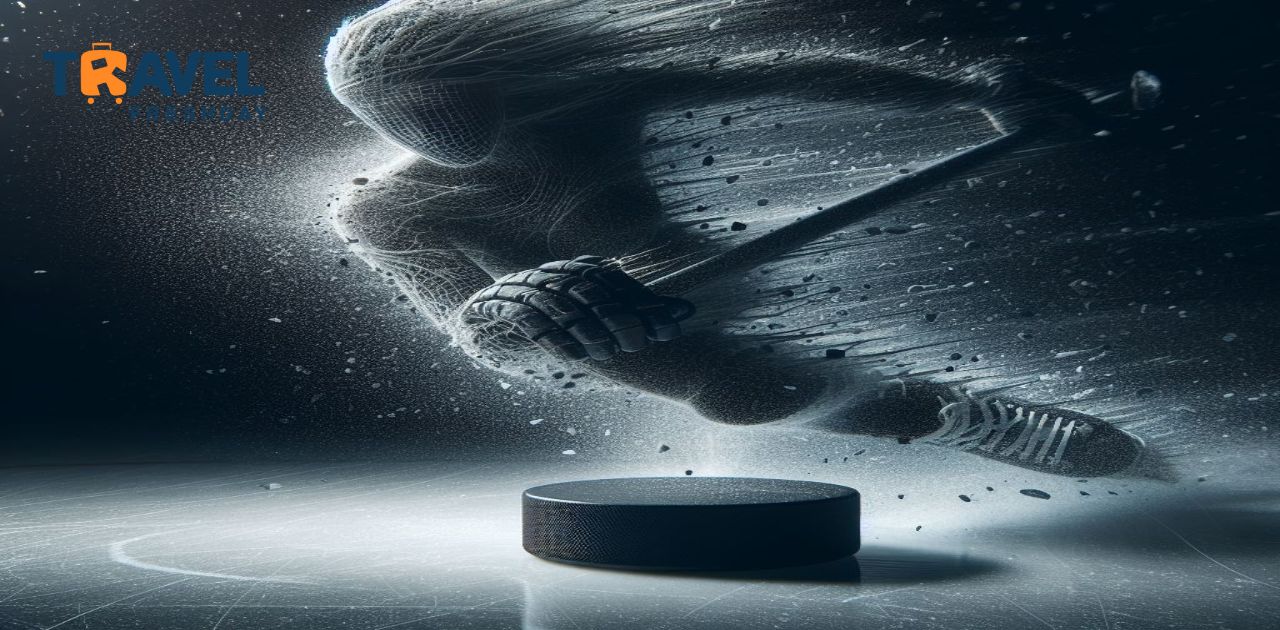Hockey, the exhilarating dance on ice, captivates audiences with its graceful glide, strategic plays, and bone-crushing checks. But amidst the adrenaline rush, one element reigns supreme in terms of sheer velocity: the hockey puck.
This unassuming, vulcanized rubber disc transforms into a blazing projectile when unleashed by a skilled player’s slap shot. So, strap on your skates and prepare to delve into the fascinating world of how fast a hockey puck can travel.
Breaking The Barrier: Record-Shattering Speeds
Hockey pucks, despite their modest appearance, can reach astonishing speeds. The current record holder is Denis Kulyash of Russia, who clocked in a blistering 110 miles per hour (177 km/h) at the 2011 KHL All-Star Game. Imagine a car hurtling down the highway at that speed – that’s the kind of force we’re talking about!
But even in regular NHL gameplay, pucks routinely reach speeds exceeding 100 miles per hour (160 km/h). Players like Zdeno Chára and Brendan Shanahan are legendary for their cannon-like shots, consistently pushing the boundaries of puck velocity.
The Science Behind The Sizzle: Unpacking The Factors
So, what propels these innocent pucks to such mind-boggling speeds? It’s a powerful cocktail of physical forces:
- Player Strength: Powerful muscles generate immense force during the slap shot, propelling the stick and, consequently, the puck, with explosive speed.
- Technique: Precision timing and flawless execution of the shot transfer maximum energy from the stick to the puck.
- Stick Flex: A stiffer stick acts like a spring, storing and releasing energy during the swing, adding extra oomph to the shot.
- Ice Conditions: A freshly resurfaced rink offers minimal friction, allowing the puck to glide effortlessly and maintain its momentum.
How Fast Is The Average Nhl Wrist Shot?
The average NHL wrist shot packs a serious punch, although it falls short of the blistering speeds of the slap shot. While the exact range can vary depending on the player and situation, most NHL wrist shots clock in between 70 and 90 miles per hour (112-145 km/h).
That’s still significantly faster than amateur players, who typically send wrist shots between 40 and 60 mph (64-96 km/h). The quick release and control of the wrist shot are why even though it doesn’t reach the same top speeds as the slap shot, it remains a highly valuable weapon in a skilled player’s arsenal.
How Fast Is Ovechkin’s Timer?
Alex Ovechkin, also known as the “Great Eight” and hockey’s ultimate power forward, is renowned for his thunderous one-timers. While the exact speed of his shot can vary depending on factors like distance and ice conditions, here’s a breakdown:
- Top Recorded Speed: Ovechkin’s fastest officially recorded slapshot was clocked at 108.8 mph (175 km/h) during a 2012 NHL All-Star Game competition. That’s faster than most highway speeds!
- Average Shot Speed: In regular NHL games, Ovechkin’s slapshots are estimated to average around 100 mph (160 km/h). Still incredibly fast, and enough to leave goalies scrambling for cover.
- Unleashing the Power: Ovechkin’s exceptional strength, technique, and use of a stiff stick all contribute to his blistering shot speed. His one-timers are a potent weapon on the power play, making him a constant threat to score.
Are Hockey Pucks Aerodynamic?
Surprisingly, hockey pucks are not very aerodynamic. Their flat, disc-like shape creates significant drag as they fly through the air, which quickly slows them down. In fact, most of the speed a puck reaches comes from the power of the player’s shot, not from any aerodynamic advantage.
However, there have been some attempts to design more aerodynamic pucks. Some patent designs feature grooves or dimples on the puck’s surface, which are meant to reduce drag and increase lift. However, these designs have not been widely adopted, as they can also make the puck bounce unpredictably on the ice.
So, while hockey pucks aren’t exactly aerodynamic marvels, they’re still capable of reaching impressive speeds thanks to the skill and power of the players who shoot them. The next time you see a slap shot rocket into the net, remember that it’s not just brute force – it’s also a testament to the player’s mastery of the game’s physics.
Does The Temperature Of A Hockey Puck?

Yes, a hockey puck’s temperature significantly impacts its travel distance. Colder pucks travel farther! Why? Warmer pucks melt a thin layer of ice on contact, creating a mini puddle of water with higher friction.
This slows them down like tires hydroplaning. That’s why the NHL chills pucks before games – colder pucks fly farther, making for faster, more exciting matches! So, next time you hit the ice, remember: keep the puck cool for peak performance.
How Far Does The Puck Slide Before Coming To Rest?
The hockey puck glides across the slick ice surface, propelled by the forceful swing of the player’s stick. Its smooth edges allow it to travel rapidly, slicing through the chilled air.
After being struck, the black rubber puck continues sliding, eventually slowing as friction from the ice causes its momentum to decrease gradually. The distance the puck covers depends on factors like the power of the initial hit and the texture of the ice.
On a freshly resurfaced rink, a strongly struck puck may coast over 50 feet before finally running out of kinetic energy and settling motionless on the glistening sheet of ice.
How Hard Does A Hockey Puck Hit?
A hockey puck can strike with incredible force. When slapped by a player’s stick or sent airborne off a blistering slap shot, a standard 6 ounce puck may reach speeds over 100 mph. This translates to a tremendous amount of kinetic energy and impact power.
According to sports scientists, a puck struck at just 70 mph exerts around 600 pounds of force against whatever it hits. At top speeds over 100 mph by professional players, the collision force can surpass 1,000 pounds.
Getting struck with a puck traveling this fast can inflict painful bruises through padding and even break bones if it strikes unprotected areas. No wonder players instinctively flinch when a blistering puck heads their way.
FAQ’s For How Fast Does A Hockey Puck Travel?
Can A Slap Shot Break A Bone?
Yes, a hockey slap shot can break a bone due to the extremely high speed the puck can reach – over 100 mph. This high kinetic energy can fracture bones on impact.
Can A Punch Hit Harder Than A Bullet?
No, the hardest punch a human can throw cannot exceed the force of a bullet fired from a gun. The fist does not have enough mass or velocity.
How Damaging Is A Slap?
A slap can be very damaging depending on the force. It can leave the skin red, swollen, and bruised. The head being slapped back can also cause neck injuries.
Do Faster Punches Hurt More?
Yes, faster punches do more damage as they impart greater force from the increased velocity behind the fist. The faster the fist, the more it will hurt.
How Fast Does A Hockey Puck Role Play?
Hockey pucks don’t role, they slide on ice! Their speed can rocket past 100 miles per hour, thanks to powerful shots and the smooth ice surface. So buckle up, it’s a fast ride.
Conclusion, For How Fast Does A Hockey Puck Travel?
Hockey pucks can go very fast. When a player hits the puck as hard as they can, it is called a slap shot. The best players can make the puck go over 100 miles per hour with a slap shot. That is faster than cars drive on the freeway.
The player uses a long stick to hit the puck very hard. When they swing the stick, it makes the puck zoom across the ice. The fast puck can crash into other players or the net. It can really hurt to be hit by the hard puck going so fast.
In summary, a hockey puck travels extremely fast when hit in a slap shot. The fastest ever recorded slap shot made the puck go 108.8 miles per hour. Getting hit by the puck at that speed would really injure a player.
That is because the fast moving puck has a lot of power. So hockey players have to be careful when someone is winding up for a big slap shot. The puck moves quickly and can do damage. But seeing players hit the fast puck is exciting for hockey fans to watch. Understanding how fast hockey pucks can go helps people enjoy the sport.
Recommended For Post: How Fast Does A Hockey Puck Travel?
Event Post: U.S. Gymnastics Olympic Trials 2024 Tickets?
Savannah Bananas Schedule : A Complete Details?







